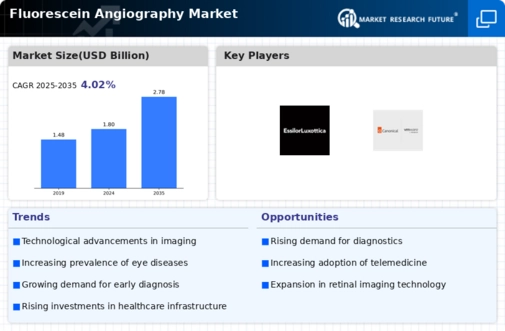Market Growth Projections
The Global Fluorescein Angiography Market Industry is projected to experience steady growth over the next decade. With a compound annual growth rate (CAGR) of 4.02% anticipated from 2025 to 2035, the market is expected to evolve in response to changing healthcare needs and technological advancements. This growth trajectory reflects the increasing demand for effective diagnostic tools in ophthalmology. As the industry adapts to new challenges and opportunities, stakeholders are likely to invest in research and development to enhance the efficacy of fluorescein angiography. The market's expansion is indicative of a broader trend towards improved eye care and patient outcomes.
Growing Awareness and Education
There is a notable increase in awareness and education regarding eye health, which is positively impacting the Global Fluorescein Angiography Market Industry. Campaigns aimed at educating the public about the importance of regular eye examinations and early detection of eye diseases are gaining traction. Healthcare professionals are also being trained to utilize fluorescein angiography effectively, ensuring that patients receive timely and accurate diagnoses. This heightened awareness is likely to lead to an increase in patient referrals for fluorescein angiography, thereby driving market growth. As more individuals seek preventive care, the demand for these imaging services is expected to rise.
Increased Healthcare Expenditure
The Global Fluorescein Angiography Market Industry is benefiting from rising healthcare expenditure across various regions. Governments and private sectors are investing more in healthcare infrastructure, which includes the acquisition of advanced diagnostic tools like fluorescein angiography systems. This trend is particularly evident in developing nations, where improved access to healthcare services is a priority. As healthcare budgets grow, the demand for effective diagnostic solutions is expected to rise, contributing to the market's growth. By 2035, the market could reach 2.78 USD Billion, reflecting the positive impact of increased investment in healthcare technologies.
Regulatory Support and Guidelines
The Global Fluorescein Angiography Market Industry is supported by regulatory frameworks and guidelines that promote the use of advanced imaging techniques. Regulatory bodies are increasingly recognizing the importance of fluorescein angiography in diagnosing and managing eye diseases. This support not only encourages healthcare providers to adopt these technologies but also fosters innovation within the industry. As regulations evolve to accommodate new technologies and methodologies, the market is likely to experience growth. The establishment of standardized protocols for fluorescein angiography could enhance its credibility and acceptance among healthcare professionals, further driving market expansion.
Rising Prevalence of Eye Diseases
The Global Fluorescein Angiography Market Industry is experiencing growth due to the increasing prevalence of eye diseases such as diabetic retinopathy and age-related macular degeneration. According to health statistics, the number of individuals diagnosed with these conditions is on the rise, leading to a higher demand for diagnostic imaging techniques. Fluorescein angiography plays a crucial role in the early detection and management of these diseases, which could potentially improve patient outcomes. As the global population ages and the incidence of diabetes increases, the market is projected to reach 1.8 USD Billion in 2024, indicating a strong need for advanced imaging solutions.
Technological Advancements in Imaging Techniques
Advancements in imaging technology are significantly influencing the Global Fluorescein Angiography Market Industry. Innovations such as high-resolution imaging and enhanced software for image analysis are improving the accuracy and efficiency of fluorescein angiography procedures. These technological improvements not only facilitate better diagnosis but also enhance patient comfort during the procedure. As healthcare providers adopt these advanced technologies, the market is likely to expand, reflecting a growing trend towards precision medicine. The integration of artificial intelligence in image interpretation may further streamline workflows, potentially leading to an increase in market value as it evolves to meet the demands of modern healthcare.



